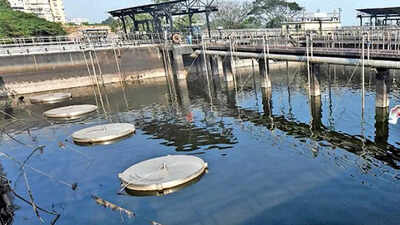- News
- City News
- ahmedabad News
- Ahmedabad digs in to guzzle groundwater
Ahmedabad digs in to guzzle groundwater
Ahmedabad digs in to guzzle groundwater

The data was collected from four wells in Ahmedabad and Vadodara each, and one well in Rajkot and Surat each
AHMEDABAD: Each day the AMC supplies 1,369 million litres of drinking water to roughly 72 lakh citizens. But daily, the municipal corporation receives 1,739 million litres of sewage at its sewage treatment plants! The difference indicates that Amdavadis draw 370 million litres of extra water from the ground every day.
There is no state-level groundwater regulation in place.
So neither the Central Ground Water Board nor the AMC nor indeed the state water resources department has comprehensive data on the number of borewells dug in residential, commercial, and industrial areas in the city.
Almost 92% of the 15.55 lakh housing units have access to a groundwater source.
More disturbing, according to the data available with the Rajya Sabha, Ahmedabad city was found to have groundwater at 67 metres (220 feet) in the confined aquifer. Ahmedabad had the third deepest groundwater aquifer after Jaipur (84.7 metres) and Dehradun (79.2 metres).
To put the figure in perspective, the deepest level in Delhi is 64 metres. In Chandigarh, it is 53.6 metres, and in Lucknow it is 45.8 metres. Other Gujarat cities fared better with the deepest level at 12.3 metres in Vadodara, 5.5 metres in Rajkot, and 4.6 metres in Surat.
The data was collected from four wells in Ahmedabad and Vadodara each, and one well in Rajkot and Surat each.
A senior AMC official said, “While studying water consumption patterns, most state agencies overlook the 7 lakh floating population that travels to the city from the neighbouring talukas, towns, and cities for work or business.” The official added: “They drink water and use toilets. No one accounts for that.”
There is no state-level groundwater regulation in place.
So neither the Central Ground Water Board nor the AMC nor indeed the state water resources department has comprehensive data on the number of borewells dug in residential, commercial, and industrial areas in the city.
Almost 92% of the 15.55 lakh housing units have access to a groundwater source.
“The state government has had a groundwater governance code since 2005. It was provided by the Centre,” said a senior official of the Narmada, water resources and water supply department. The official said: “But the government is yet to implement it as a state law.”
More disturbing, according to the data available with the Rajya Sabha, Ahmedabad city was found to have groundwater at 67 metres (220 feet) in the confined aquifer. Ahmedabad had the third deepest groundwater aquifer after Jaipur (84.7 metres) and Dehradun (79.2 metres).
To put the figure in perspective, the deepest level in Delhi is 64 metres. In Chandigarh, it is 53.6 metres, and in Lucknow it is 45.8 metres. Other Gujarat cities fared better with the deepest level at 12.3 metres in Vadodara, 5.5 metres in Rajkot, and 4.6 metres in Surat.
The data was collected from four wells in Ahmedabad and Vadodara each, and one well in Rajkot and Surat each.
A senior AMC official said, “While studying water consumption patterns, most state agencies overlook the 7 lakh floating population that travels to the city from the neighbouring talukas, towns, and cities for work or business.” The official added: “They drink water and use toilets. No one accounts for that.”
FacebookTwitterLinkedinEMail
Start a Conversation
end of article
Quick Links
Delhi Air PollutionDelhi TemperatureChennai WeatherBangalore TemperatureCovid vaccination centres in DelhiCoronavirus in DelhiRTPCR test in GurgaonHyderabad RainPollution level in BangaloreDelhi SmogDelhi TemperatureNoida AQIGurgaon AQI todayFire in MumbaiMumbai RainsCovid 19 RT PCR Test in NoidaDelhi AQI todaySrinagar encounter

